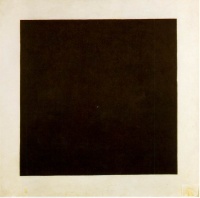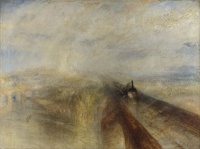Abstraction (art)
From The Art and Popular Culture Encyclopedia
|
"The sense of painting as an art primarily of form rather than of representation won growing acceptance toward the end of the nineteenth century. The French painter and writer Maurice Denis (1870–1943) pointed out in 1890 that "it is well to remember that a picture -- before being a battle horse, a nude woman, or some anecdote—is essentially a plane surface covered with colors assembled in a certain order." In lectures delivered at Harvard in the 1890s, Santayana speculated on the possibility of a "new abstract art" that would "deal with colors as music does with sound." Along similar lines, the German architect August Endell (1871–1925) spoke in 1898 about “the beginning of a totally new art, an art with forms that mean nothing and represent nothing and remind one of nothing; yet that will be able to move our souls so deeply, as before only music has been able to do with tones." The writings of the German art historian Wilhelm Worringer (1881–1965) lent further prestige to the aesthetics of abstraction. In his influential Abstraktion und Einfühlung: Ein Beitrag zur Stilpsychologie (1908), he asserted that throughout history nonrepresentational art [...] reflected a society's distrust of materiality and a correspondingly greater attraction the world of the spirit." --Absolute Music: The History of an Idea, 2014, Mark Evan Bonds |
|
Related e |
|
Featured: |
Typically, abstraction is used in the arts as a synonym for abstract art in general.
In the visual arts
Strictly speaking, it refers to art unconcerned with the literal depiction of things from the visible world—it can, however, refer to an object or image which has been distilled from the real world, or indeed, another work of art. Artwork that reshapes the natural world for expressive purposes is called abstract; that which derives from, but does not imitate a recognizable subject is called nonobjective abstraction. In the 20th century the trend toward abstraction coincided with advances in science, technology, and changes in urban life, eventually reflecting an interest in psychoanalytic theory. Later still, abstraction was manifest in more purely formal terms, such as color, freedom from objective context, and a reduction of form to basic geometric designs and shapes.
In music
In music, the term abstraction can be used to describe improvisatory approaches to interpretation, and may sometimes indicate abandonment of tonality. Atonal music has no key signature, and is characterized by the exploration of internal numeric relationships.




